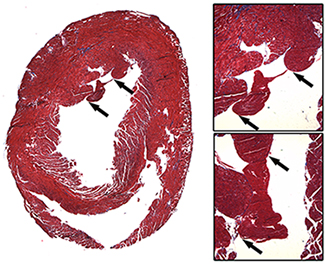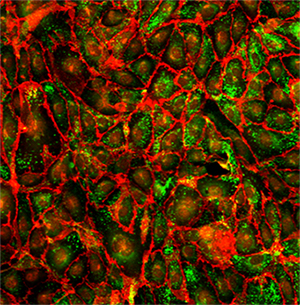Research Areas
Thrombosis Within Cardiac Chambers
Thromboembolic complications are a significant cause of morality and re-hospitalization in heart failure patients. One potential source of thrombi is the endocardial endothelial surface of the heart. The Hasan Lab is interested in understanding how nerve-endothelial interactions are dysregulated in heart failure, resulting in a compromised endothelium and increased propensity for thrombus formation.

Figure 1 shows the margins of an intracardiac thrombus in early heart failure mice; these thrombi can block blood flow in the heart’s chambers or embolize to other parts of the body, resulting in pulmonary embolism, deep vein thrombosis or stroke. From Endocardial Endothelial Dysfunction Progressively Disrupts Initially Anti then Pro-Thrombotic Pathways in Heart Failure Mice.
Cardiac Arrhythmias and Aberrant Cardiac Nerves
Arrhythmias can cause clots to form and result in sudden cardiac death. One potential mechanism for arrhythmia generation is heterogeneous nerve patterning and activity. The Hasan Laboratory is interested in understanding the mechanisms for this aberrant nerve patterning in pathological states such as obesity and heart failure.

Figure 2 shows cultured human cardiac endocardial endothelial cells from a patient with heart failure. The cells were immunostained for von Willebrand factor (vWF) (green) as well as vascular endothelial-cadherin (red). The disorganized vWF pattern reflects a prothrombotic state in heart failure. Reprinted from Autonomic Neuroscience 206, Tyrrell C, Toyooka A, Khan F, Thornburg KL, Mudd JO, Hasan W, The Neuropeptide Galanin Promotes an Anti-Thrombotic Phenotype on Endocardial Endothelial Cells from Heart Failure Patients, 25-42, Copyright 2017, with permission from Elsevier.
Contact the Hasan Lab
Advanced Health Sciences Pavilion, A8200
127 S. San Vicente Blvd.
Los Angeles, CA 90048